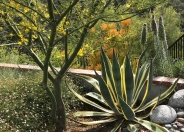
Common name: Variegated Century Plant
Botanical name: Agave americana 'Variegata'
This Agave has a creamy yellow margins around the edge of the leaves. It will grow 6'-10' tall by up to 13' wide. It is native to Mexico. It has a very open growth habit, with leaves that recurve along their length.
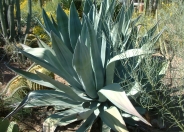
Common name: Century Plant, Maguey
Botanical name: Agave americana
This plant is fast growing to about 6'-10' tall and 8'-13' wide. Wide gray leaves have stiff terminal spines and recurved teeth on margins. It prefers full sun and well-drained situations. After blooming, which could take several years, it will die but will send up new pups from around the base. Some people are allergic to the sap. Removal is difficult if unwanted.
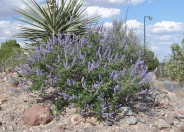
Common name: Chaste Tree, Monk's Pepper Tree
Botanical name: Vitex agnus-castus
Chaste Tree is not a tree but a deciduous shrub that quickly grows to 20' tall and wide. It has beautiful, fragrant lavender or white flowers in summer which is striking against the gray green, slender, pointed leaves. Butterflies love this shrub too. It full sun and medium amount of watering, more in summer. It tolerates coastal conditions but needs heat to look its best. Prune spent flowers to keep it tidy looking.

Common name: Yellow Moraea, Fortnight Lily
Botanical name: Dietes bicolor
This clumping perennial Iris relative stands 3'-4' high and 3' wide. It has light yellow, iris-like flowers with maroon blotches that are about 2" wide. It performs best in full sun in coastal areas and appreciates afternoon shade or complete light shade in warm, inland areas. It does best with regular watering and well draining soil. Flowers only bloom one day but another one will bloom the following day, blooming from spring through fall. Foliage is evergreen, long, thin and sword-like.
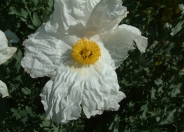
Common name: Matilija Poppy
Botanical name: Romneya coulteri
This wonderful California native perennial can reach 5' tall and 8' wide. Foliage is gray green and 3-5 lobes. Large white flowers with yellow centers appear in spring and summer. Slightly scented, attracting bees and butterflies. This plant does best in full or part sun with well draining soil. However, it does spread by underground runners so consider planting on slopes or in areas where it is allowed to spread. Flowers are great for vase arrangements. This plant is drought tolerant once it's established.
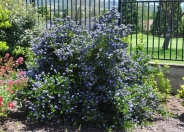
Common name: Dark Star Ceanothus
Botanical name: Ceanothus 'Dark Star'
Dark Star Ceanothus grows to 6' tall and 8' wide, producing small, rounded clusters of dark blue flowers from light burgundy buds that appear in spring. Its habit is compact, with small, dark green, dimpled leaves growing to only 1/2" long. This shrub does best in full sun in coastal areas with well draining soil. It needs very little water once it's established.

Common name: Yellow Moraea, Fortnight Lily
Botanical name: Dietes bicolor
This clumping perennial Iris relative stands 3'-4' high and 3' wide. It has light yellow, iris-like flowers with maroon blotches that are about 2" wide. It performs best in full sun in coastal areas and appreciates afternoon shade or complete light shade in warm, inland areas. It does best with regular watering and well draining soil. Flowers only bloom one day but another one will bloom the following day, blooming from spring through fall. Foliage is evergreen, long, thin and sword-like.
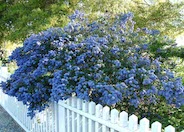
Common name: Concha California Lilac
Botanical name: Ceanothus 'Concha'
Concha is a lilac that grows 6'-8' in height and width. It has small narrow, glossy, dark green leaves with intense dark blue flower clusters in spring. It is tolerant of coastal and inland conditions. Most ceanothus varieties do not tolerate a lot of summer irrigation but this cultivar does. It also tolerates clay and alkali soil better than other varieties. It is hard frost tolerant.
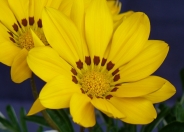
Common name: Hybrid Gazanias
Botanical name: Gazania hybrids
These ground covers will grow less than 1' tall and spread about 1'. They have medium size, gray green leaves with gold, lavender, orange, red, yellow, or white daisy-like flowers that are present all year in many areas. In other areas, flowers bloom in summer and fall. These ground covers do well in full or part sun with well draining soil. They tolerate salt spray, sandy, dry, poor soil. It can be grown in desert areas but will need extra summer water. Some varieties are trailing types which can be planted on hillsides or put in large containers.